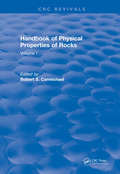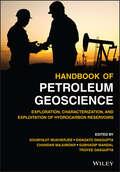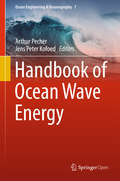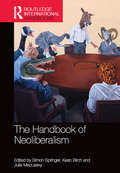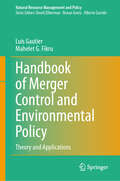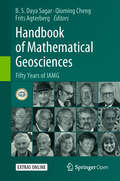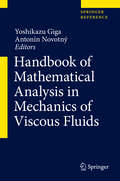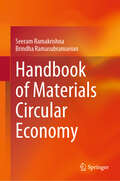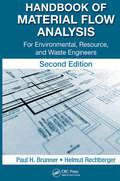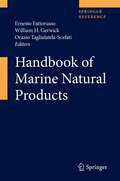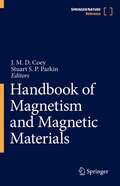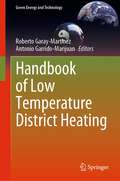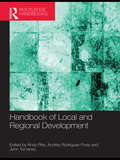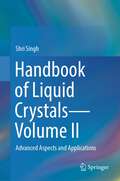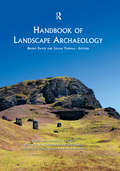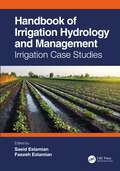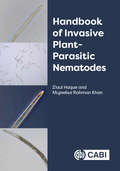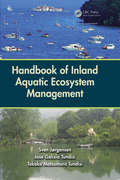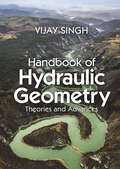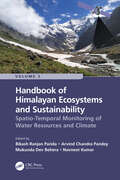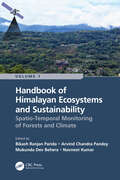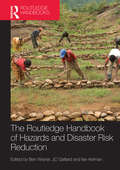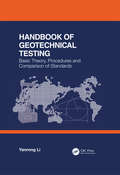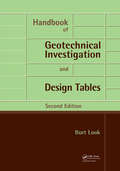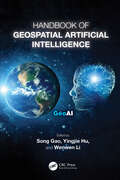- Table View
- List View
Handbook of Physical Properties of Rocks: Volume I (CRC Press Revivals)
by Robert S. CarmichaelThis three-volume handbook provides reliable, comprehensive data on the properties of rocks, minerals, and other related materials. The format is largely tabular and graphical, designed for ease of use in comparisons and referencing. The chapters are contributed by recognized experts from leading university, industrial, and governmental scientific establishments.
Handbook of Petroleum Geoscience: Exploration, Characterization, and Exploitation of Hydrocarbon Reservoirs
by Soumyajit Mukherjee Troyee Dasgupta Swagato Dasgupta Chandan Majumdar Subhadip MandalHANDBOOK OF PETROLEUM GEOSCIENCE This reference brings together the latest industrial updates and research advances in regional tectonics and geomechanics. Each chapter is based upon an in-depth case study from a particular region, highlighting core concepts and themes as well as regional variations. Key topics discussed in the book are: Drilling solutions from the Kutch offshore basin Geophysical studies from a gas field in Bangladesh Exploring Himalayan terrain in India Tectonics and exploration of the Persian Gulf basin Unconventional gas reservoirs in the Bohemian Massif This book is an invaluable industry resource for professionals and academics working in and studying the fields of petroleum geoscience and tectonics.
Handbook of Ocean Wave Energy
by Arthur Pecher Jens Peter KofoedThis book is open access under a CC BY-NC 2. 5 license. This book offers a concise, practice-oriented reference-guide to the field of ocean wave energy. The ten chapters highlight the key rules of thumb, address all the main technical engineering aspects and describe in detail all the key aspects to be considered in the techno-economic assessment of wave energy converters. Written in an easy-to-understand style, the book answers questions relevant to readers of different backgrounds, from developers, private and public investors, to students and researchers. It is thereby a valuable resource for both newcomers and experienced practitioners in the wave energy sector.
Handbook of Neoliberalism
by Simon Springer Kean Birch Julie MacLeavyNeoliberalism is easily one of the most powerful discourses toemerge within the social sciences in the last two decades, and the number of scholars who write about this dynamic and unfolding process of socio-spatial transformation isastonishing. Even more surprising though is that there has, until now, not been an attempt to provide a wide-ranging volume that engages with the multiple registers in which neoliberalism has evolved. The Routledge Handbook of Neoliberalism seeks to offer a comprehensive overview of the phenomenon of neoliberalism by examining the range of ways that it has been theorized, promoted, critiqued, and put into practice in a variety of geographical locations and institutional frameworks. With contributions from over 50 leadingauthors working at institutions around the world the volumes seven sections will offer a systematic overview of neoliberalism’s origins, political implications, social tensions, spaces, natures and environments, and aftermaths in addressing ongoing and emerging debates. The volume aims to provide the first comprehensive overview of the field and to advance the established and emergent debates in a field that has grown exponentially over the past two decades, coinciding with the meteoric rise of neoliberalism as a hegemonic ideology, state form, policy and program, and governmentality. It includes a substantive introductory chapter and will serve as an invaluable resource for undergraduates, graduate students, and professional scholars alike.
Handbook of Merger Control and Environmental Policy: Theory and Applications (Natural Resource Management and Policy #59)
by Luis Gautier Mahelet G. FikruThis book presents an integrated theory of firms’ strategies and two types of policies, namely environmental policies, and merger control policies. It develops a framework to examine the intricate relationship between merger and acquisition (M&A) incentives, merger control policy, environmental policies, and firms’ sustainability practices. The chapters highlight the importance of policy coordination to underscore the link between M&A and environmental externality, and the link between merger policy and environmental policy. Drawing together related fields that are seldom linked in the literature, this volume offers a comprehensive and authoritative reference for scholars, graduate students, and policymakers.
Handbook of Mathematical Geosciences: Fifty Years of IAMG
by Frits Agterberg B.S. Daya Sagar Qiuming ChengThis Open Access handbook published at the IAMG's 50th anniversary, presents a compilation of invited path-breaking research contributions by award-winning geoscientists who have been instrumental in shaping the IAMG. It contains 45 chapters that are categorized broadly into five parts (i) theory, (ii) general applications, (iii) exploration and resource estimation, (iv) reviews, and (v) reminiscences covering related topics like mathematical geosciences, mathematical morphology, geostatistics, fractals and multifractals, spatial statistics, multipoint geostatistics, compositional data analysis, informatics, geocomputation, numerical methods, and chaos theory in the geosciences.
Handbook of Mathematical Analysis in Mechanics of Viscous Fluids
by Yoshikazu Giga Antonín NovotnýMathematics has always played a key role for researches in fluid mechanics. The purpose of this handbook is to give an overview of items that are key to handling problems in fluid mechanics. Since the field of fluid mechanics is huge, it is almost impossible to cover many topics. In this handbook, we focus on mathematical analysis on viscous Newtonian fluid. The first part is devoted to mathematical analysis on incompressible fluids while part 2 is devoted to compressible fluids.
Handbook of Materials Circular Economy
by Seeram Ramakrishna Brindha RamasubramanianThis book provides comprehensive and practical information on the design and implementation of circular systems for various industries, with a focus on Environmental, Social, and Governance (ESG) factors. The scope of the handbook is to cover the materials circularity in a deeper analysis in accordance to ESG used in various industries such as oil and gas, IT, electronics, medicine, textile, and more. The handbook also covers the key principles of the circular economy, including material efficiency, resource conservation, and waste reduction, and how they impact to different industries. It further critically analyses the challenges and opportunities associated with implementing circular systems in these industries, including the framework for new business models and technical innovations, and the potential benefits in terms of environmental protection, social responsibility, and economic competitiveness. In addition to providing practical information, the handbookalso addresses the ESG factors associated with the circular economy exclusively for each industry. This would include the impact of circular systems on the environment, including the reduction of greenhouse gas emissions and the protection of biodiversity, as well as the social benefits, such as job creation, and the economic benefits, such as cost savings and increased competitiveness. The ultimate goal of the handbook should be to provide guidance and support in a niche evaluation for the development of a more sustainable and equitable future, where the circular economy is a key enabler.
Handbook of Material Flow Analysis: For Environmental, Resource, and Waste Engineers, Second Edition (Advanced Methods In Resource And Waste Management Ser.)
by Paul H. Brunner Helmut RechbergerIn this second edition of a bestseller, authors Paul H. Brunner and Helmut Rechberger guide professional newcomers as well as experienced engineers and scientists towards mastering the art of material flow analysis (MFA) from the very beginning to an advanced state of material balances of complex systems. Handbook of Material Flow Analysis: For Environmental, Resource, and Waste Engineers, Second Edition serves as a concise and reproducible methodology as well as a basis for analysis, assessment and improvement of anthropogenic systems through an approach that is helpfully uniform and standardized. The methodology featured in this book is a vital resource for generating new data, fostering understanding, and increasing knowledge to benefit the growing MFA community working in the fields of industrial ecology, resource management, waste management, and environmental protection. This new second edition takes into account all new developments and readers will profit from a new exploration of STAN software, newly added citations, and thoroughly described case studies that reveal the potential of MFA to solve industrial ecology challenges.
Handbook of Marine Natural Products
by Ernesto Fattorusso Orazio Taglialatela-Scafati William H. Gerwick"Handbook of Marine Natural Products" takes a fresh approach to describing the major themes of research in this rapidly developing field. This two volume reference work begins with a section that provides a taxonomic survey of the secondary metabolites of diverse marine life including microbes, algae, and invertebrates. This is followed by a demonstration of the techniques and strategies employed in modern structure elucidation of complex natural products. The natural roles of marine natural products are then explored in a series of focused chapters which include the topics of symbiosis, anti-predation and antifouling, chemical interactions, and defence against UV stress. Various routes which facilitate the understanding of marine natural product biosynthesis are subsequently explained and these are followed by an extensive set of chapters on the biomedical potential of marine natural products. The latter portion of this section considers the technologies and scientific disciplines necessary for advancing bioactive marine natural product lead compounds into actual pharmaceuticals. The reference work finishes with a selection of chapters describing marine toxins and their impact on public health and seafood resources. Final thoughts presented at the end of the second volume focus on the future of this field of investigation and discovery research. This publication is presented as a reference handbook and general concepts are emphasized and illustrated with numerous interesting examples, graphical information, and a comprehensive index. "Handbook of Marine Natural Products" introduces students who are at advanced undergraduate and entry graduate student levels to this fascinating multidisciplinary field. It is an ideal desk companion for courses focusing on this contemporary area.
Handbook of Magnetism and Magnetic Materials
by J. M. D. Coey Stuart S. P. ParkinThis handbook presents a comprehensive survey of magnetism and magnetic materials. The dramatic advances in information technology and electromagnetic engineering make it necessary to systematically review the approved key knowledge and summarize the state of the art in this vast field within one seminal reference work. The book thus delivers up-to-date and well-structured information on a wealth of topics encompassing all fundamental aspects of the underlying physics and materials science, as well as advanced experimental methodology and applications. It features coverage of the host of fascinating and complex phenomena that arise from the use of magnetic fields in e.g. chemistry and biology. Edited by two internationally renowned scholars and featuring authored chapters from leading experts in the field, Springer’s Handbook of Magnetism and Magnetic Materials is an invaluable source of essential reference information for a broad audience of students, researchers, and magnetism professionals.
Handbook of Low Temperature District Heating (Green Energy and Technology)
by Roberto Garay-Martinez Antonio Garrido-MarijuanThis book reviews the history and evolution of district heating networks, with a focus on current and future issues of the district heating sector. Novel developments in the field of low temperature district heating are studied, limitations for safe operation and avoidance of bacteria are considered, and the associated improved performance of the system with fewer network losses is presented.This book showcases how the evolution of district heating networks is linked to the increased use of renewables and de-carbonized heat sources with specific focus to waste heat streams and solar energy systems. Considering the novelty of these technologies, technological developments and funding schemes for these investments are still immature to some extent. For that reason, a comprehensive review of the main aspects of energy planning as well as district heating economics and financing schemes for large-scale investments in renewable energy systems for district energy systems is performed.In the light of digitalization, networks are increasingly monitored, allowing for a drastic change in the approach for network operation. This book also explores the increased digitization and monitoring of networks and how this impacts network operation.This book is of interest to engineers, academics and officials interested in energy systems, presenting readers with the key concepts and tools to adapt to the evolution of district heating into an integrated, digitized and higher performing system.
Handbook of Local and Regional Development
by Andy PikeThe Handbook of Local and Regional Development provides a comprehensive statement and reference point for local and regional development. The scope of this Handbook’s coverage and contributions engages with and reflects upon the politics and policy of how we think about and practise local and regional development, encouraging dialogue across the disciplinary barriers between notions of ‘local and regional development’ in the Global North and ‘development studies’ in the Global South. This Handbook is organized into seven inter-related sections, with an introductory chapter setting out the rationale, aims and structure of the Handbook. Section one situates local and regional development in its global context. Section two establishes the key issues in understanding the principles and values that help us define what is meant by local and regional development. Section three critically reviews the current diversity and variety of conceptual and theoretical approaches to local and regional development. Section four address questions of government and governance. Section five connects critically with the array of contemporary approaches to local and regional development policy. Section six is an explicitly global review of perspectives on local and regional development from Africa, Asia-Pacific, Europe, Latin America and North America. Section seven provides reflection and discussion of the futures for local and regional development in an international and multidisciplinary context. With over forty contributions from leading international scholars in the field, this Handbook provides critical reviews and appraisals of current state-of-the-art conceptual and theoretical approaches and future developments in local and regional development.
Handbook of Liquid Crystals—Volume II: Advanced Aspects and Applications
by Shri SinghThis expert and self-contained authored handbook provides comprehensive coverage of liquid crystals from the fundamental materials science, physics, and modeling through cutting-edge applications. Written by an author with over 40 years of active experience in this growing field, it offers an unprecedented self-contained treatment of this key research area.Liquid Crystals are a state of matter sharing properties that are usually associated with both solids and liquids. Their study belongs to wider field of soft condensed matter physics, an area growing in importance because of the new physics being discovered and the possibilities of various technological applications being developed. Liquid crystals continue to have a revolutionary technological impact and consistently pose new challenges of basic understanding. While the experimental side of liquid crystal research is very well developed, theoretical understanding has lagged, and this volume fills a gap in the published literature in terms of rigorous treatment of mathematical and computer modeling approaches.Volume II of this handbook deals with advanced aspects of liquid crystals and their applications, covering computer simulations of phase transitions in liquid crystals, liquid crystals of biomolecules, and defect textures in liquid crystals. Overall, this handbook serves as the ultimate scholarly guide for researchers, scientists, and engineers seeking to unlock the full potential of liquid crystals. It offers a comprehensive understanding of these materials and their diverse applications, empowering readers to navigate the complex intricacies of liquid crystal science and technology.
Handbook of Landscape Archaeology (World Archaeological Congress Research Handbooks Ser. #1)
by Julian Thomas Bruno DavidOver the past three decades, "landscape" has become an umbrella term to describe many different strands of archaeology. From the processualist study of settlement patterns to the phenomenologist's experience of the natural world, from human impact on past environments to the environment's impact on human thought, action, and interaction, the term has been used. In this volume, for the first time, over 80 archaeologists from three continents attempt a comprehensive definition of the ideas and practices of landscape archaeology, covering the theoretical and the practical, the research and conservation, and encasing the term in a global framework. As a basic reference volume for landscape archaeology, this volume will be the benchmark for decades to come. All royalties on this Handbook are donated to the World Archaeological Congress.
Handbook of Irrigation Hydrology and Management: Irrigation Case Studies
by Saeid Eslamian Faezeh EslamianEver-increasing population growth has caused a proportional increased demand for water, and existing water sources are depleting day by day. Moreover, with the impact of climate change, the rates of rainfall in many regions have experienced a higher degree of variability. In many cities, government utilities have been struggling to maintain sufficient water for the residents and other users. The Handbook of Irrigation Hydrology and Management: Irrigation Case Studies examines and analyzes irrigated ecosystems in which water storage, applications, or drainage volumes are artificially controlled in the landscape and the spatial domain of processes varies from micrometers to tens of kilometers, while the temporal domain spans from seconds to centuries. The continuum science of irrigation hydrology includes the surface, subsurface (unsaturated and groundwater systems), atmospheric, and plant subsystems. Further, the book includes practical case studies from around the world, including locations such as Africa, Australia, China, India, the Middle East, the United States, and more. Features: Offers water-saving strategies to increase the judicious use of scarce water resources Presents strategies to maximize agricultural yield per unit of water used for different regions Compares irrigation methods to offset changing weather patterns and impacts of climate change
Handbook of Invasive Plant-parasitic Nematodes
by Dr Ziaul Haque Dr Mujeebur Rahman KhanPlant parasitic nematodes are major pests of agricultural crops and cause huge monetary losses. There is a very high risk of spread of plant-parasitic nematodes from one country to another, with the movement of plants and planting materials such as seeds, bulbs, corms, suckers, tubers, rhizomes, rooted plants, nursery stock and cut flowers. In view of the large quantities and the wide variety of materials being imported and exported, it is important to assess the status of invasive nematodes and their quarantine importance in relation to agricultural trade. This book contains information on around 100 invasive nematodes and their potential threat in different countries. Each nematode entry includes information on authentic identification, geographical distribution, risk of introduction, host ranges, symptoms, biology, ecology, planting material liable to carry the nematode(s), nematode vectors, chance of establishment, likely impact, and phytosanitary measures. There are detailed accounts of diagnosis procedures including sampling, isolation, detection and identification of nematodes based on morphological and molecular characters. The book offers a global perspective on invasive plant-parasitic nematodes and useful for practitioners, professionals, scientists, researchers, students, and government officials working in plant quarantine and biosecurity.
Handbook of Inland Aquatic Ecosystem Management
by Sven Jorgensen Jose Galizia Tundisi Takako Matsumura TundisiCombining background knowledge and practical tools, Handbook of Inland Aquatic Ecosystem Management gives you an overview of how to manage inland waters in a holistic manner. It examines the problems that threaten aquatic inland water ecosystems and presents a set of toolboxes for solving them. The book focuses on lakes, reservoirs, ponds, rivers,
Handbook of Hydraulic Geometry: Theories and Advances
by Vijay SinghHydraulic geometry describes the relations between stable channel characteristics and discharge and adjustments made by a stream in response to changes in river discharge and sediment load. This book introduces hydraulic geometry and discusses different theories and their applications in river engineering, thus providing a comprehensive summary for hydraulic engineers, as well as graduate students and researchers in fluvial geomorphology and hydraulic and environmental engineering. Topics covered include the basis of power form of hydraulic geometry relations, validity and stability of power relations, state and assumption of equilibrium, variability of exponents, variation of channel width and velocity, and the effect of stream size and river channel patterns.
Handbook of Himalayan Ecosystems and Sustainability, Volume 2: Spatio-Temporal Monitoring of Water Resources and Climate
by Navneet Kumar Mukunda Dev Behera Bikash Ranjan Parida Arvind Chandra PandeyVolume 2: Handbook of Spatio-Temporal Monitoring of Water Resources and Climate is aimed to describe the current state of knowledge and developments of geospatial technologies (Remote Sensing and Geographic Information Systems) for assessing and managing water resources under climate change. It is a collective achievement of renowned researchers and academicians working in the Hindu Kush Himalayan (HKH) mountain range. The HKH region is a part of the Third Pole outside the polar regions due to its largest permanent snow cover. Importantly, the Himalayan belt is geologically fragile and vulnerable to geohazards (e.g. landslides, land subsidence, rockfalls, debris flow, avalanches, and earthquakes). Therefore, critical assessment and geospatial solutions are indispensable to safeguard the natural resources and human beings in the Himalayas using space-borne satellite datasets. This book also showcases various remote sensing techniques and algorithms in the field of urban sprawling, urban microclimate and air pollution. The potential impacts of climate change on the cryosphere and water resources are also highlighted. This comprehensive Handbook is highly interdisciplinary and explains the role of geospatial technologies in studying the water resources of the Himalayas considering climate change. Key Features This book is unique as it focuses on the utility of satellite data for monitoring snow cover variability, snowmelt runoff, glacier lakes, avalanche susceptibility and flood modeling. Explain how Remote Sensing techniques are useful for mapping and managing the morphology and ecology of the Himalayan River. Addresses how geospatial technologies are valuable for understanding climate change impact on hydrological extremes, the potential impact of land use/land cover change (LULC) on hydrology and water resources management. It highlights the impact of LULC changes on land surface temperature, groundwater, and air pollution in urban areas. Includes contributions from global professionals working in the HKH region. Readership The Handbook serves as a valuable reference for students, researchers, scientists, Hydrologists, hydro-ecologists, meteorologists, geologists, decision makers and all others who wish to advance their knowledge on monitoring and managing water resources and urban ecosystem using remote sensing in the HKH region considering climate change.
Handbook of Himalayan Ecosystems and Sustainability, Volume 1: Spatio-Temporal Monitoring of Forests and Climate
by Navneet Kumar Mukunda Dev Behera Bikash Ranjan Parida Arvind Chandra PandeyVolume 1: Spatio-Temporal Monitoring of Forests and Climate is aimed to describe the recent progress and developments of geospatial technologies (remote sensing and GIS) for assessing, monitoring and managing fragile Himalayan ecosystems and their sustainability under climate change. It is a collective research contribution from renowned researchers and academicians working in the Hindu Kush Himalayan (HKH) mountain range. The Himalayas ecosystems have been facing substantial transformation due to severe environmental conditions, land transformation, forest degradation and fragmentation. The authors utilized satellite datasets and algorithms to discuss the intricacy of land use/land cover change, forest and agricultural ecosystems, canopy height estimation, above-ground biomass, wildfires, carbon sequestration, and landscape restoration. Furthermore, the potential impacts of climate change on ecosystems, biodiversity and future food and nutritional security are also addressed including the impact on the livelihood of people of the Himalayas. This comprehensive Handbook explains the advanced geospatial technologies for mapping and management of natural resources of the Himalayas. Key Features Explains multiple aspects of geospatial technologies for studying fragile Himalayan ecosystems and sustainability Focuses on the utility of interferometric synthetic aperture radar (SAR) modeling for canopy height Explain how remote sensing techniques are useful for deriving the above-ground biomass, gross primary productivity (GPP), and carbon fluxes Addresses how geospatial technologies are valuable for understanding vegetation dynamics, composition and landscape restoration due to shifts in timberline and forest fires Includes contributions from global professionals working in the HKH mountain range Readership The Handbook serves as a valuable reference for students, researchers, scientists, ecologists, agricultural scientists, meteorologists, decision makers and all others who wish to advance their knowledge on vegetation remote sensing considering climate change in the HKH region.
Handbook of Hazards and Disaster Risk Reduction
by Jc Gaillard Ilan Kelman Ben WisnerThe Handbook provides a comprehensive statement and reference point for hazard and disaster research, policy making, and practice in an international and multi-disciplinary context. It offers critical reviews and appraisals of current state of the art and future development of conceptual, theoretical and practical approaches as well as empirical knowledge and available tools. Organized into five inter-related sections, this Handbook contains sixty-five contributions from leading scholars. Section one situates hazards and disasters in their broad political, cultural, economic, and environmental context. Section two contains treatments of potentially damaging natural events/phenomena organized by major earth system. Section three critically reviews progress in responding to disasters including warning, relief and recovery. Section four addresses mitigation of potential loss and prevention of disasters under two sub-headings: governance, advocacy and self-help, and communication and participation. Section five ends with a concluding chapter by the editors. The engaging international contributions reflect upon the politics and policy of how we think about and practice applied hazard research and disaster risk reduction. This Handbook provides a wealth of interdisciplinary information and will appeal to students and practitioners interested in Geography, Environment Studies and Development Studies.
Handbook of Geotechnical Testing: Basic Theory Procedures And Comparison Of Standards
by Yanrong LiDetermination of the physical, chemical and mechanical properties of ground materials is the key to successfully deliver such projects as slope stabilization, excavation and lateral support, foundation etc. A book containing both theory of geomaterial testing and up-to-date testing methods is much in demand for obtaining reliable and accurate test results. This book is intended primarily to serve this need and aims at the clear explanation, in adequate depth, of the fundamental principles, requirements and procedures of soil and rock tests. It is intended that the book will serve as a useful source of reference for professionals in the field of geotechnical and geological engineering. It can work as a one-stop knowledge warehouse to build a basic cognition of material tests on which the readers are working. It helps college students bridge the gap between class education and engineering practice, and helps academic researchers guarantee reliable and accurate test results. It is also useful for training new technicians and providing a refresher for veterans. Engineers contemplating the ICE, IOM3 and other certification exams will find this book an essential test preparation aid. It is assumed that the reader has no prior knowledge of the subject but has a good understanding of basic mechanics.
Handbook of Geotechnical Investigation and Design Tables: Second Edition
by Burt G. LookThis practical handbook of properties for soils and rock contains in a concise tabular format the key issues relevant to geotechnical investigations, assessments and designs in common practice. There are brief notes on the application of the tables. These data tables are compiled for experienced geotechnical professionals who require a reference do
Handbook of Geospatial Artificial Intelligence
by Song Gao Yingjie Hu Wenwen LiThis comprehensive handbook covers Geospatial Artificial Intelligence (GeoAI), which is the integration of geospatial studies and AI machine (deep) learning and knowledge graph technologies. It explains key fundamental concepts, methods, models, and technologies of GeoAI, and discusses the recent advances, research tools, and applications that range from environmental observation and social sensing to natural disaster responses. As the first single volume on this fast-emerging domain, Handbook of Geospatial Artificial Intelligence is an excellent resource for educators, students, researchers, and practitioners utilizing GeoAI in fields such as information science, environment and natural resources, geosciences, and geography. Features Provides systematic introductions and discussions of GeoAI theory, methods, technologies, applications, and future perspectives Covers a wide range of GeoAI applications and case studies in practice Offers supplementary materials such as data, programming code, tools, and case studies Discusses the recent developments of GeoAI methods and tools Includes contributions written by top experts in cutting-edge GeoAI topics This book is intended for upper-level undergraduate and graduate students from different disciplines and those taking GIS courses in geography or computer sciences as well as software engineers, geospatial industry engineers, GIS professionals in non-governmental organizations, and federal/state agencies who use GIS and want to learn more about GeoAI advances and applications.
